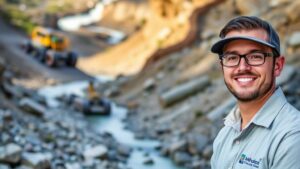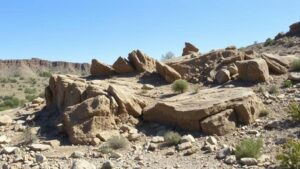Recognizing Gossans as Surface Indicators of Copper Deposits
Recognizing Gossans as Surface Indicators of Copper Deposits
Gossans play a pivotal role in mineral exploration, especially in the identification of copper deposits. Characterized by their oxide-rich, weathered surfaces, gossans provide essential clues about the underlying mineralization processes. This article delves into the nature of gossans, their significance in copper exploration, and the practical applications of recognizing these surface indicators.
What are Gossans?
Gossans are formed through the weathering and oxidation of mineral deposits, particularly those containing sulfide minerals such as chalcopyrite and pyrite. process typically begins when sulfide minerals are exposed to atmospheric conditions, which leads to the leaching of metals and the formation of secondary oxides, hydroxides, and silicate minerals. This process can result in a distinctive surface layer, which contains iron oxides (like hematite and goethite) and other metal oxides.
The Role of Gossans in Copper Exploration
Gossans serve as important geochemical and geological markers in the search for copper deposits. These surface features can indicate the presence of copper sulfides at deeper levels. For example, in regions where copper sulfide veins are present, gossans can often be observed at the surface, providing a direct link to potentially significant mineralization below.
One well-documented case of this phenomenon can be seen in the African Copperbelt. Here, extensive gossan development has pointed geologists towards massive copper-cobalt deposits beneath the surface. The gossan formations are characterized by a rich array of oxides, vividly signaling the underlying mineral presence.
Identifying Gossans in the Field
Field identification of gossans involves several key observations:
- Coloration: Gossans are typically bright orange to yellow due to the oxidation of iron and other metals.
- Texture: The texture can be friable or conglomerate, often differing from the surrounding rock.
- Associated Spendings: Presence of other mineralized structures, such as quartz veins, can indicate proximity to significant deposits.
Also, geochemical tests, such as portable X-ray fluorescence (pXRF), can provide quantitative data on metal concentrations within gossans, allowing for a more objective assessment of potential underlying deposits.
Real-World Applications and Case Studies
Beyond the theoretical aspects, real-world applications underscore the practical importance of recognizing gossans. One notable example is the Bingham Canyon Mine in Utah, one of the largest open-pit copper mines in the world. The gossanous cover over mineralized areas has guided exploration efforts, ensuring efficient identification of copper-rich zones.
Another case is found in the Punjab region of Pakistan, where mapping gossan formations has led to successful exploration campaigns resulting in the discovery of economically viable copper deposits, emphasizing the importance of these indicators in mining operations.
Challenges in Gossan Identification
While gossans are valuable indicators, several challenges can arise in their identification:
- Variability in Composition: Gossans can vary significantly in mineral composition based on environmental conditions and pre-existing geological formations, leading to ambiguity in analysis.
- Human Error: Field identification may be subjective, necessitating thorough training for geologists and explorers.
Addressing these challenges requires a multi-faceted approach that combines field observations with advanced scientific techniques such as geochemical analysis and remote sensing, increasing the likelihood of accurate identification and subsequent exploration success.
Conclusion and Actionable Takeaways
Recognizing gossans as surface indicators of copper deposits offers enormous potential for exploration and mining. By understanding their formation, characteristics, and the context in which they appear, geologists can significantly enhance their ability to locate valuable copper resources.
In summary, here are key takeaways:
- Gossans are formed from the weathering of sulfide minerals and can indicate the presence of copper deposits below.
- Characterizing gossans through field observations can guide effective exploration strategies.
- Combining traditional identification methods with advanced technologies enhances accuracy and efficiency in identifying potential deposits.
For exploration companies and geologists, leveraging the unique features of gossans can lead to greater geological insight and improved resource discovery. Further studies and technological advancements in this regard are likely to refine exploration methodologies, making the identification of copper deposits more efficient and systematic.


